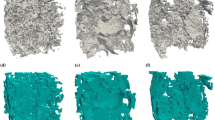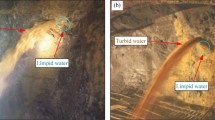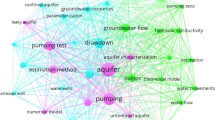Abstract
This laboratory study improves the understanding of the impacts of horizontal hydraulic gradient, artificial recharge, and groundwater pumping on solute transport through aquifers. Nine experiments and numerical simulations were carried out using a sand tank. The variable-density groundwater flow and sodium chloride transport were simulated using the three-dimensional numerical model SEAWAT. Numerical modelling results successfully reproduced heads and concentrations observed in the sand tank. A higher horizontal hydraulic gradient enhanced the migration of sodium chloride, particularly in the groundwater flow direction. The application of constant artificial recharge increased the spread of the sodium chloride plume in both the longitudinal and lateral directions. In addition, groundwater pumping accelerated spreading of the sodium chloride plume towards the pumping well. Both higher hydraulic gradient and pumping rate generated oval-shaped plumes in the horizontal plane. However, the artificial recharge process produced stretched plumes. These effects of artificial recharge and groundwater pumping were greater under higher hydraulic gradient. The concentration breakthrough curves indicated that emerging solutions never attained the concentration of the originally injected solution. This is probably because of sorption of sodium chloride onto the silica sand and/or the exchange of sodium chloride between the mobile and immobile liquid domains. The fingering and protruding plume shapes in the numerical models constitute instability zones produced by buoyancy-driven flow. Overall, the results have substantiated the influences of hydraulic gradient, boundary condition, artificial recharge, pumping rate and density differences on solute transport through a homogeneous unconfined aquifer. The implications of these findings are important for managing liquid wastes.
Résumé
Cette étude de laboratoire améliore la compréhension des impacts du gradient hydraulique horizontal, de la recharge artificielle et du pompage des eaux souterraines sur le transport de soluté dans les aquifères. Neuf essais et simulations numériques ont été menés dans un réservoir sableux. Un écoulement d’eau souterraine à densité variable et un transfert de chlorure de sodium ont été simulés à l’aide du modèle numérique tridimensionnel SEAWAT. Les résultats de la modélisation numérique ont reproduit fidèlement les charges et les concentrations observées dans le réservoir sableux. Un gradient hydraulique horizontal plus élevé a accru la migration du chlorure de sodium, particulièrement dans la direction de l’écoulement souterrain. L’application d’une recharge artificielle constante a augmenté la propagation du panache de chlorure de sodium à la fois dans la direction longitudinale et dans la direction latérale. De plus, le pompage des eaux souterraines a accéléré la progression du panache de chlorure de sodium vers le puits de pompage. Un gradient hydraulique et un débit de pompage plus élevés ont tous deux généré des panaches de sodium de forme ovale dans le plan horizontal. Toutefois, le processus de recharge artificielle produit des panaches distendus. Ces effets de la recharge artificielle et du pompage des eaux souterraines ont été plus forts pour des gradients hydrauliques plus élevés. Les courbes de percée ont montré que les solutions émergentes n’atteignent jamais en sortie la concentration de la solution injectée en entrée. Ceci est. probablement dû à l’adsorption du chlorure de sodium sur les sables silicatés et/ou à l’échange du chlorure de sodium entre les domaines d’eau mobiles et immobiles. Les formes digitées et protubérantes du panache dans les modèles numériques constituent des zones d’instabilité produites par un écoulement contrôlé par la flottabilité. De manière générale, les résultats ont fourni la preuve de l’influence du gradient hydraulique, des conditions aux limites, de la recharge artificielle, du débit de pompage et des différences de densité sur le transport de soluté dans un aquifère libre homogène. Les implications de ces conclusions sont importantes pour la gestion d’effluents.
Resumen
Este estudio de laboratorio mejora la comprensión de los impactos del gradiente hidráulico horizontal, la recarga artificial y el bombeo de aguas subterráneas en el transporte de solutos a través de los acuíferos. Nueve experimentos y simulaciones numéricas se llevaron a cabo utilizando un tanque de arena. El flujo de agua subterránea de densidad variable y el transporte de cloruro de sodio se simularon utilizando el modelo numérico tridimensional SEAWAT. Los resultados del modelado numérico reprodujeron con éxito las cargas hidráulicas y las concentraciones observadas en el tanque de arena. Un gradiente hidráulico horizontal más elevado mejoró la migración de cloruro de sodio, particularmente en la dirección del flujo del agua subterránea. La aplicación de recarga artificial constante aumentó la propagación de la pluma de cloruro de sodio en las direcciones longitudinal y lateral. Además, el bombeo de aguas subterráneas aceleró la dispersión de la columna de cloruro de sodio hacia el pozo de bombeo. Tanto el gradiente hidráulico más alto como la velocidad de bombeo generaron plumas de forma ovalada en el plano horizontal. Sin embargo, el proceso de recarga artificial produjo plumas estiradas. Estos efectos de la recarga artificial y el bombeo de aguas subterráneas fueron mayores bajo un gradiente hidráulico más alto. Las curvas de avance indicaron que las soluciones emergentes nunca alcanzaron la concentración de la solución inyectada originalmente. Esto es probablemente debido a la sorción del cloruro de sodio en la arena de sílice y/o al intercambio de cloruro de sodio entre los dominios líquidos móviles e inmóviles. La digitación y las formas de la pluma que sobresalen en los modelos numéricos constituyen zonas de inestabilidad producidas por el flujo impulsado por flotación. En general, los resultados han corroborado las influencias del gradiente hidráulico, las condiciones de contorno, la recarga artificial, la velocidad de bombeo y las diferencias de densidad en el transporte de solutos a través de un acuífero homogéneo no confinado. Las implicancias de estos hallazgos son importantes para el manejo de los residuos líquidos.
摘要
这个室内研究增进了人们对水平水力梯度、人工补给和地下水抽取对溶质通过含水层运移的影响的认识。利用沙箱进行了9项试验 和模拟。采用三维数值模型SEAWAT模拟了可变密度地下水流及氯化钠运移。数值建模成功地再现了沙箱中观测到的水头和浓度。较高的水平水力梯度增强了氯化钠的迁移,特别是在地下水流方向上。应用不变的人工补给增加了纵向和横向氯化钠羽的扩散。另外,地下水抽取加速了氯化钠羽向抽水井扩散。较高的水力梯度和较高的抽水量在水平面上产生了椭圆形的羽。然而,人工补给过程产生了延伸的羽。在较高的水力梯度下,这些人工补给和地下水抽水的效果较大。突破曲线表明,出现的溶液从来没有达到原来注入溶液的浓度。这可能是因为氯化钠吸附在二氧化硅砂上以及或者流动及非流动液体域之间氯化钠交换造成的。模型中突出的羽形状构成了浮动驱动水流产生的不稳定带。总之,结果证明了水力梯度、边界条件、人工补给、抽水量以及密度差对溶质通过均质非承压含水层运移的影响。这些发现对于管理液体废物非常重要。
Resumo
Esse estudo laboratorial melhora o entendimento dos impactos do gradiente hidráulico vertical, recarga artificial, e bombeamento de águas subterrâneas no transporte de soluto entre aquíferos. Nove experimentos e simulações numéricas foram conduzidos utilizando um tanque de areia. O fluxo das águas subterrâneas de densidade variável e o transporte de cloreto de sódio foram simulados utilizando o modelo tridimensional SEAWAT. Os resultados da simulação numérica reproduziram com sucesso as cargas e concentrações observadas no tanque de areia. Um gradiente hidráulico horizontal maior melhorou a migração de cloreto de sódio, particularmente na direção do fluxo das águas subterrâneas. A aplicação de uma recarga artificial constante aumentou a propagação da pluma de cloreto de sódio nas direções longitudinal e lateral. Além disso, o bombeamento de águas subterrâneas acelerou a propagação da pluma de cloreto de sódio para o poço de bombeamento. Tanto o gradiente hidráulico mais alto como a taxa de bombeamento geraram plumas com forma oval no plano horizontal. No entanto, o processo de recarga artificial produziu plumas esticadas. Esses efeitos da recarga artificial e do bombeamento de águas subterrâneas foram maiores sob gradiente hidráulico mais alto. As curvas de identificação indicaram que soluções emergentes nunca atingiram a concentração da solução inicialmente injetada. Isto provavelmente é devido à sorção de cloreto de sódio na areia de sílica e/ou à troca de cloreto de sódio entre os domínios líquidos e móveis imobilizados. As formas em dedo e protuberantes das plumas nos modelos numéricos constituem zonas de instabilidade produzidas pelo fluxo impulsionado por flutuabilidade. No geral, os resultados têm fundamentado as influências do gradiente hidráulico, condição de contorno, recarga artificial, taxa de bombeamento e diferenças de densidade no transporte de soluto através de um aquífero homogêneo não confinado. As implicações dessas descobertas são importantes para o gerenciamento de efluentes.














Similar content being viewed by others
References
Anderson MP, Woessner WW, Hunt RJ (2015) Applied groundwater modeling: simulation of flow and advective transport. Academic, San Diego, CA
Chang CM, Yeh HD (2008) Using the nonstationary spectral method to analyze asymptotic macrodispersion in uniformly recharged heterogeneous aquifers. J Hydrol 350(1):93–99
Chen JS (2010) Analytical model for fully three-dimensional radial dispersion in a finite-thickness aquifer. Hydrol Process 24(7):934–945
Chen JS, Chen CS, Gau HS, Liu CW (1999) A two-well method to evaluate transverse dispersivity for tracer tests in a radially convergent flow field. J Hydrol 223(3):175–197
Chen JS, Liu CW, Chen CS, Liao CM (2003) Effect of well bore mixing volume on non-axisymmetrical transport in a convergent radial tracer test. J Hydrol 277(1):61–73
Chen JS, Liu CW, Liang CP (2006) Evaluation of longitudinal and transverse dispersivities/distance ratios for tracer test in a radially convergent flow field with scale-dependent dispersion. Adv Water Resour 29(6):887–898
Cirpka OA, Olsson Å, Ju Q, Rahman MD, Grathwohl P (2006) Determination of transverse dispersion coefficients from reactive plume lengths. Ground Water 44(2):212–221
Clement TP, Kim YC, Gautam TR, Lee KK (2004) Experimental and numerical investigation of DNAPL dissolution processes in a laboratory aquifer model. Ground Water Monit Rem 24(4):88–96
Elfeki AM, Uffink GJ, Lebreton S (2007) Simulation of solute transport under oscillating groundwater flow in homogeneous aquifers. J Hydraul Res 45(2):254–260
Fetter CW (1999) Contaminant hydrogeology. Prentice Hall, Upper Saddle River, NJ, 500 pp
Fetter CW (2001) Applied hydrogeology. Prentice Hall, Upper Saddle River, NJ, 598 pp
Foussereau X, Graham WD, Akpoji GA, Destouni G, Rao PSC (2001) Solute transport through a heterogeneous coupled vadose-saturated zone system with temporally random rainfall. Water Resour Res 37(6):1577–1588
Goode DJ, Konikow LF (1990) Apparent dispersion in transient groundwater flow. Water Resour Res 26(10):2339–2351
Guo W, Langevin CD (2002) Users guide to SEAWAT: a computer program for simulation of three-dimensional variable-density ground-water flow. US Geological Survey Techniques of Water-Resources Investigations, book 6, chap A7. US Geological Survey, Reston, VA
Harbaugh AW, Banta ER, Hill MC, McDonald MG (2000) MODFLOW-2000, the U.S. Geological Survey Modular Groundwater Model: user guide to modularization concepts and the ground-water process. US Geol Surv Open-File Rep 00-92
Johnson AI (1967) Specific yield: compilation of specific yields for various materials. US Gov. Printing Office, Washington, DC, pp 1–74
Katz Y, Gvirtzman H (2000) Capture and cleanup of a migrating VOC plume by the in-well vapor stripping: a sand tank experiment. J Contam Hydrol 43(1):25–44
Kim J, Park Y, Harmon TC (2005) Real-time model parameter estimation for analyzing transport in porous media. Ground Water Monit Rem 25(2):78–86
Langevin CD, Thorne DT, Dausman AM, Sukop MC, Guo W (2008) SEAWAT Version 4: a computer program for simulation of multispecies solute and heat transport. US Geol. Surv. Tech. Methods, book 6, chap A22. US Geological Survey, Reston, VA
Li L, Graham WD (1998) Stochastic analysis of solute transport in heterogeneous aquifers subject to spatially random recharge. J Hydrol 206(1–2):16–38
Li L, Graham WD (1999) Stochastic analysis of solute transport in heterogeneous aquifers subject to spatiotemporal random recharge. Water Resour Res 35(4):953–971
Mastrocicco M, Prommer H, Pasti L, Palpacelli S, Colombani N (2011) Evaluation of saline tracer performance during electrical conductivity groundwater monitoring. J Contam Hydrol 123(3):157–166
Ojuri OO, Ola SA (2010) Estimation of contaminant transport parameters for a tropical sand in a sand tank model. Int J Environ Sci Technol 7(2):385–394
Paschke NW, Hoopes JA (1984) Buoyant contaminant plumes in groundwater. Water Resour Res 20(9):1183–1192
Pickens JF, Lennox WC (1976) Numerical simulation of waste movement in steady groundwater flow systems. Water Resour Res 12(2):171–180
Pinto MJ, Gvirtzman H, Gorelick SM (1997) Laboratory-scale analysis of aquifer remediation by in-well vapor stripping: 2. modeling results. J Contam Hydrol 29:41–58
Pollock DW (1994) User’s guide for MODPATH/MODPATH-PLOT, version 3: a particle tracking post-processing package for MODFLOW, the US Geological Survey finite-difference ground-water flow model. US Geol Surv Open-File Rep 94-464
Qian J, Wu Y, Zhang Y, Liu Y, Lu Y, Yu Z (2015) Evaluating differences in transport behavior of sodium chloride and brilliant blue FCF in sand columns. Transp Porous Media 109(3):765–779
Rolle M, Eberhardt C, Chiogna G, Cirpka OA, Grathwohl P (2009) Enhancement of dilution and transverse reactive mixing in porous media: experiments and model-based interpretation. J Contam Hydrol 110(3):130–142
Rubin Y, Bellin A (1994) The effects of recharge on flow nonuniformity and macrodispersion. Water Resour Res 30(4):939–948
Russo D, Zaidel J, Laufer A (2000) Numerical analysis of flow and transport in a combined heterogeneous vadose zone–groundwater system. Adv Water Resour 24(1):49–62
Schincariol RA, Schwartz FW (1990) An experimental investigation of variable density flow and mixing in homogeneous and heterogeneous media. Water Resour Res 26(10):2317–2329
Sternberg SP, Cushman JH, Greenkorn RA (1996) Laboratory observation of nonlocal dispersion. Transp Porous Media 23(2):135–151
Swartz CH, Schwartz FW (1998) An experimental study of mixing and instability development in variable-density systems. J Contam Hydrol 34(3):169–189
Toride NL, Leij FJ, van Genuchten MT (1999) The CXTFIT code for estimating transport parameters from laboratory or field tracer experiments, version 2.1, research report, no. 137. US Salinity Laboratory, Riverside, CA
Welty C, Gelhar LW (1991) Stochastic analysis of the effects of fluid density and viscosity variability on macrodispersion in heterogeneous porous media. Water Resour Res 27(8):2061–2075
Welty C, Gelhar LW (1992) Simulation of large-scale transport of variable density and viscosity fluids using a stochastic mean model. Water Resour Res 28(3):815–827
Welty C, Gelhar LW (1994) Evaluation of longitudinal dispersivity from nonuniform flow tracer tests. J Hydrol 153(1–4):71–102
Xie Y, Simmons CT, Werner AD (2011) Speed of free convective fingering in porous media. Water Resour Res 47(11):W11501. https://doi.org/10.1029/2011WR010555
Xie Y, Simmons CT, Werner AD, Diersch HJ (2012) Prediction and uncertainty of free convection phenomena in porous media. Water Resour Res 48(2):W02535. https://doi.org/10.1029/2011WR011346
Yu Z, Schwartz FW (1999) Determining concentration fields of tracer plumes for layered porous media in flow-tank experiments. Hydrogeol J 7(2):236–240
Zhang D, Neuman SP (1996) Head and velocity covariances under quasi-steady state flow and their effects on advective transport. Water Resour Res 32(1):77–83
Zheng C (2006) MT3DMS v5.2 supplemental user’s guide: technical report to the U.S. Army Engineer Research and Development Center. Dept. of Geological Sciences, University of Alabama, 24 pp
Zheng C, Wang PP (1999) MT3DMS, a modular three-dimensional multispecies model for simulation of advection, dispersion and chemical reactions of contaminants in groundwater systems: documentation and user’s guide. USAERDC contract report SERDP-99-1. US Army Engineer Research and Development Center, Vicksburg, MS
Acknowledgements
The authors would like to thank the anonymous reviewers for their insightful comments and a number of useful suggestions.
Funding
The research work is funded by the National Natural Science Foundation of China for the research project entitled “Study on water cycle evolution of groundwater reservoir in the arid area under artificial regulation (41572210)”.
Author information
Authors and Affiliations
Corresponding author
Rights and permissions
About this article
Cite this article
Atlabachew, A., Shu, L., Wu, P. et al. Numerical modeling of solute transport in a sand tank physical model under varying hydraulic gradient and hydrological stresses. Hydrogeol J 26, 2089–2113 (2018). https://doi.org/10.1007/s10040-018-1758-6
Received:
Accepted:
Published:
Issue Date:
DOI: https://doi.org/10.1007/s10040-018-1758-6




